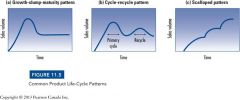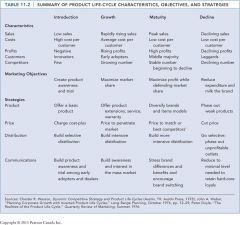![]()
![]()
![]()
Use LEFT and RIGHT arrow keys to navigate between flashcards;
Use UP and DOWN arrow keys to flip the card;
H to show hint;
A reads text to speech;
23 Cards in this Set
- Front
- Back
|
How do you increase your # of market shares? |
Acquire new users Get existing users to use your product more |
|
|
2 components of proactive marketing? Define each. |
Responsive anticipation: company finds stated consumer need and fills it
Creative anticipation: company discovers secret need and fills it before the consumer realizes they even need it
|
|
|
What are the 6 types of defense strategies? Define each. |
Position defender: market leader defends the product's position in the consumers' minds (best product ever!)
Flank defense: protect your weak fronts
Pre emptive defense: market leader attacks the smaller company before they even establish their ground
Counteroffensive defense: market leaders both attack each other (leader drops their price, attacker has to meet it, etc.)
Mobile defense: marketer moves into new areas/industries
Contraction defense: gives up weaker markets and uses its resources for its stronger areas |
|
|
What is a company's optimal market share? 100%? |
No.
Normally around 50%.
Profitability is highest at this point because past this point it costs more to acquire the additional market than the profit you would be making off of it (your quality might go down, cost might be too much) |
|
|
What 3 things must market challengers do? |
1) define strategic objective & opponents 2) choose general attack strategy 3) choose specific attack strategy |
|
|
Name the 5 general attack strategies? Describe each one. |
1) Frontal attack: match the opponent's move. Side with greater resources will win.
2) Flank attack: identify shifts that cause gaps develop then fill those gaps.
3) Encirclement attack: attack on several different fronts
4) Bypass attack: diversify into new markets where the leader is not
5) Guerilla warfare: teeny tiny attacks (selective price cuts, extensive promotional blitzes) that are expensive and need a second strategy behind them to work |
|
|
What are some specific attack strategies? |
Price discount Product innovation Distribution innovation Improved services Intensive advertising promotion etc. |
|
|
What are 4 market follower strategies? |
1) Counterfeiter: makes everything identical and sells it on the black market (illegally) 2) Cloner: emulates the product but has slight variations 3) Imitator: copies but differentiates as well 4) Adapter: copies and adapts or improves the product |
|
|
What is a niche strategy and what are niche specialist roles? |
Be a leader in a small market that the big guys just aren't interested in.
Specialist roles: End user specialist Product line specialist Quality-price specialist Customer size specialist Specific customer specialist Geographic specialist Job shop specialist Service specialist |
|
|
What are the 4 general rules of product life cycles? |
1. Products have a limited life cycle 2. Product sales pass through distinct stages. 3. Profits rise and fall at different stages 4. Products require different strategies in each life cycle stage. |
|
|
Know how to draw a sales and profit life cycle. |

|
|
|
Know how to draw: Cycle recycle pattern Scalloped pattern |

|
|
|
Growth slump maturity pattern, common with: |
appliances
rapid growth when first introduced. declines but is sustained by late adopters and people replacing their products |
|
|
Cycle recycle pattern, common with: |
Medicine
First introduced to solve all problems, high growth, it fades, new advertisements produce some more growth but not as high and doesn't last as long |
|
|
Scalloped growth pattern, common with: |
Nylon and Apple
Keep finding new uses for it or new features that boost sales when they go down with the previous product |
|
|
What are the 3 stages of a product life cycle? |
Introduction Growth Maturity |
|
|
What are introduction stage strategies? |
Inform customers Encourage trials Gain distribution outlets
Prices are high because costs are high |
|
|
What are growth stage strategies? |
Improve quality Add new features Add flanker products/new models Drop prices for next level of buyers Shift from awareness to preference & loyalty Enter new market segments Enter new distribution channels
|
|
|
What are the 3 components of the maturity stage? |
Growth Stable Decaying maturity |
|
|
What are 3 strategies to stretch out the maturity phase? |
Market modification: increase usage rate & increase number of users
Product modification: add new features to get users to use it one
Marketing program modification: modify non product elements like price, distribution, and promotion |
|
|
What are 3 strategies for the declining phase? |
Leave it alone: let it finish its course on its own Modify marketing strategy: try and get it to sell just a little bit longer Drop it: allocate resources to other products, stop producing it. |
|
|
Review & know table 11.2 |

|
|
|
How should you market in an economic downturn? |
Invest Get closer to customers Review budgets Fine tune offerings Use compelling value proposition |

